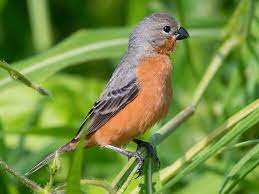Description
Wing-barred Seedeater
The Wing-barred Seedeater (Sporophila americana) is a small passerine bird native to coastal regions of northeastern South America, particularly in Venezuela, Tobago, the Guianas, and northeastern Brazil. This species, about 11 cm in length, is known for its seed-eating habits, feeding on a diet that includes seeds, flowers, buds, and fruits. It thrives in open or semi-open grassy areas, pastures, and scrubby, weedy habitats, often seen in pairs or small flocks, sometimes mixing with other seedeater species.
Identification:
- Males: Distinctive black-and-white plumage, characterized by a thick black bill, a black back with a greyish rump, two prominent white wing-bars, and a white underbody featuring a black pectoral collar, which may vary in intensity and coverage.
- Females: Duller in color, with buffy-olive upperparts, pale olive-ochre underparts, and a brownish bill. Juveniles resemble adult females.
Males show variation across the range, with those in Ecuador and Peru generally being darker and those along the northeastern coast paler. This variation previously led to some classification confusion, as the Wing-barred Seedeater was once grouped with the Central American Sporophila corvina and the west Amazonian S. murallae as subspecies under the collective name “Variable Seedeater.” However, these are now considered separate species.
This bird’s characteristic black bill with a curved culmen, white throat, and collar create a cowled appearance that differentiates it from other seedeaters, especially where no overlap occurs with the similar Variable Seedeater. Females, however, can be challenging to identify distinctly due to their unremarkable brownish plumage, often indistinguishable from other female seedeaters.









Reviews
There are no reviews yet.